Bricks on the Wing
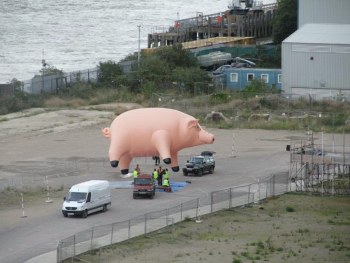
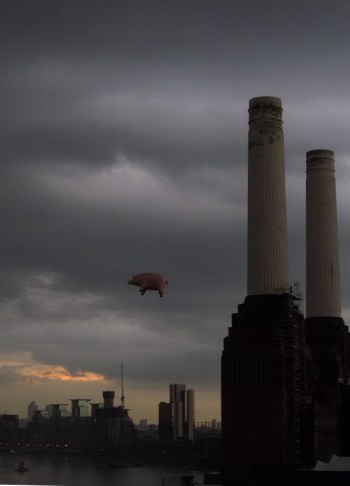
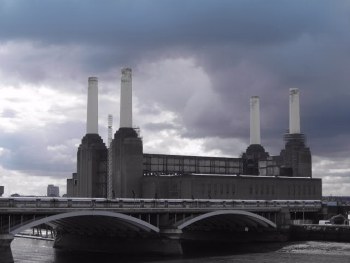
Time Lapse Sample
Full Time Lapse - The view is gone!
The Panorama - Feb 2013
This view will be gone 2016
For timelapse update of current building contact info@t2k.com
Before Battersea Power Station, there was Dream City. Well, nearly.
This whimsical example of Unbuilt London was meant to appear in 1908 on the site later occupied by Battersea Power Station.
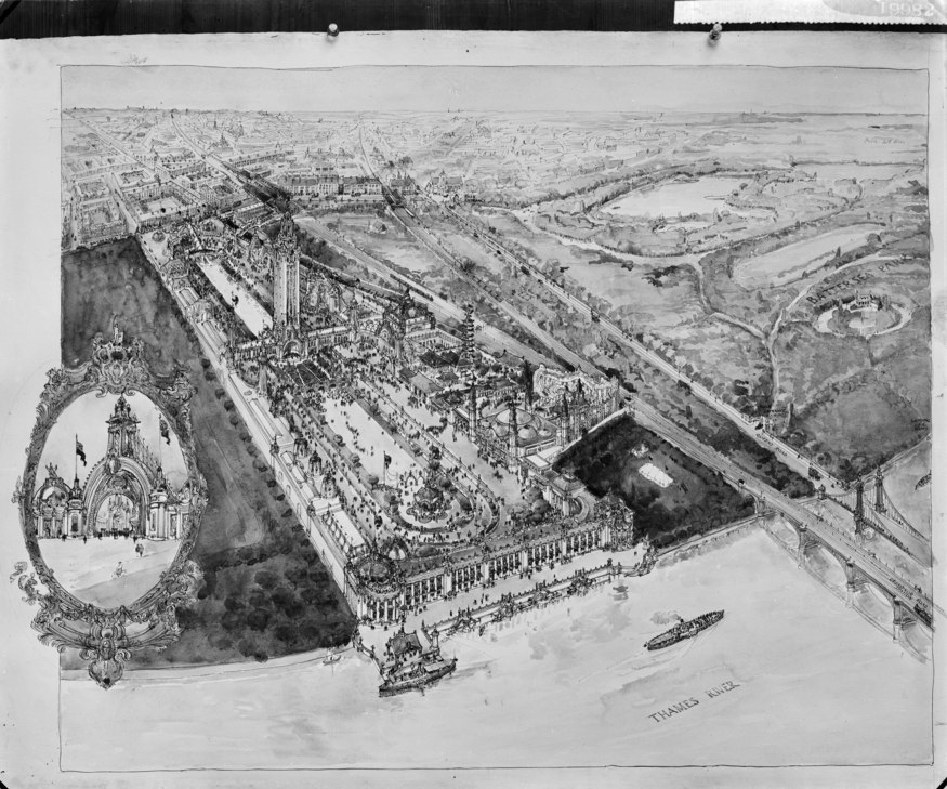
The Dream City which never happened
At the time, the 15-acre plot next to Chelsea Bridge was a disused waterworks that an American developer thought would make the perfect location for London’s answer to Coney Island’s Dreamland. He would construct an open-air pleasure palace that would feature exotic rides, charming gardens and sundry other entertainments. The public would come in their thousands.
It’s precisely the sort of spiel that was heard throughout the 1980s, 1990s and 2000s, as developers unveiled their bravura plans for the disused Battersea Power Station, insisting each time that they’d finally hit upon the perfect solution for the isolated, tumbledown relic.
The power station had been began operating in 1933 and stopped producing electricity in 1983, after which it was sold to private developers following a fudged competition. One of the first owners wanted to turn the building into a theme park just like Dream City, a London sibling to his own Alton Towers, with a host of thrilling rides crammed inside the brick shell. Margaret Thatcher, wearing a hard hat and wielding a massive laser gun, attended The Battersea’s naming ceremony in 1988 promising great things. The scheme soon fell apart.
Photo by Dave Gorman in the Londonist Flickr pool
As did that earlier plan for Dream City, despite it getting plenty of publicity and the approval of the LCC. Dream City was the brainchild of American engineer John Walter Frink Bennett, working alongside Canadian architect Francis Swales. They’d met in London, where Bennett had worked on the Ritz and Waldorf hotel as well as several Underground stations. Swales would later consult on the great beaux-arts frontage of Selfridges department store.
Dream City was going to open in May 1908. It would feature lakes, rides and promenades, an illuminated tower, and the tasteful-sounding “Esquimaux settlement” and “midget village”.
As plans held in the London Metropolitan Archives show, it was very much in the spirit of the times, carrying something of the atmosphere of a World Fair, with dramatic permanent architecture — in this case, the gigantic central illuminated tower, like a square lighthouse, surrounded by an elegant array of ornate pavilions and gardens. There would be a roller coaster and helter-skelter, but most tantalising were reports of exotic rides such as the submarine that would take passengers beneath the lake to gaze on “weird ocean monsters, wrecks and divers”, and a subterranean roller coaster that would carry riders along a track populated by ghosts, animated skeletons and a cave featuring “strange reptiles [that] will crawl across the track in front of the car”. The site would be illuminated by one million electric lights.
Dream City was never built, possibly scuppered by similar but more advanced plans for the Franco-British Exhibition, which opened at White City in 1908. Bennett returned to New York where, ironically, he served as acting commissioner of water supply. The Battersea waterworks remained derelict for another twenty years until work began on Battersea Power Station, a building that would eventually bring light to not just 15 acres, but half of London.
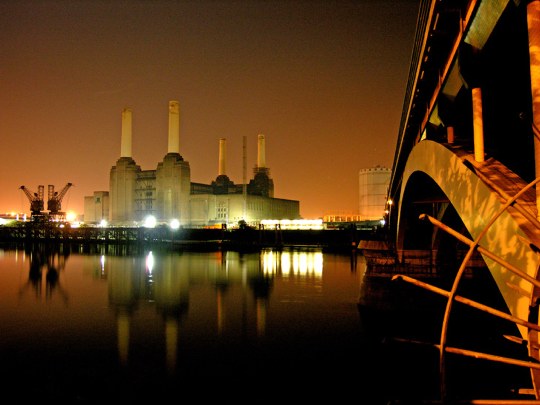
For decades, people have attempted to turn this part of Battersea into a theme park
But the vestiges of Dream City never entirely left this industrial corner of Battersea. As a working power station, the building was regularly incorporated into the fantasy of film and TV, providing a memorable backdrop for album covers and science fiction series. And when the power station closed down in 1983, it became once more a place of dreams, a building that people looked upon and wondered, imagining alternative uses and speculating about what might be done with its noble rotting hulk.
Over the decades, ideas have included casinos, race courses, cinemas, football grounds, mosques, managed ruins and museums. In one short spell, it was going to become a giant Noddyland, a “religious theme park” (former Page 3 girl Sam Fox was tangentially drawn into this one) and, most disturbingly, a “self-contained fantasy centre” owned by Michael Jackson. All of these dreams came to nothing, dissolving in the London air like the smoke that once billowed from those four gargantuan chimneys.
Now it finally looks as if something is being done about Battersea Power Station, although how many Londoners dream about another development of luxury flats is open to debate.
A Malaysian consortium seem to be succeeding where so many have failed, constructing a dense collage of flats, hotels and offices around the power station itself, which, after it is finally renovated and restored, will be turned into a giant shopping centre spotted with flats, offices and leisure facilities.
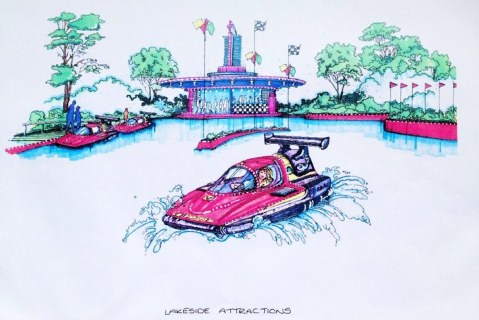
They call it an urban village. It’s certainly not Dream City.
Up In Smoke: The Failed Dreams Of Battersea Power Station by Peter Watts (Paradise Road, £20) is out on 26 April.
History of the Construction
The proposal to site a large power station on the south bank of the River Thames at Battersea in 1927 caused a storm of protest that raged for years. Questions were raised in Parliament about pollution which might harm the paintings in the nearby Tate Gallery and the parks and "noble buildings of London".
Now Battersea Power Station is one of the best loved landmarks after serving London with electricity for 50 years.
In the UK during the 1920s electricity was supplied by numerous private companies who built small power stations for individual industries with some of the surplus power generated going to the public supply. There was a bewildering variety of incompatible systems, high cost and jealous competition between the numerous companies. This chaotic situation caused Parliament to decree that electricity generation should be a single unified system under public ownership.It was to be another 30 years before the electricity supply was nationalised.
In the interim the formation of the London Power Company was a response by private owners to delay the imposition of public ownership. Set up in 1925 it took up Parliaments recommendation that electricity generation should be in fewer, larger power stations. This led directly to the building of the first super station, to produce 400,000 kilowatts, in Battersea.
Sir Giles Gilbert Scott was commissioned to design the building. His other buildings include Liverpool Cathedral, Bankside Power Station, Waterloo Bridge and the classic red telephone box.
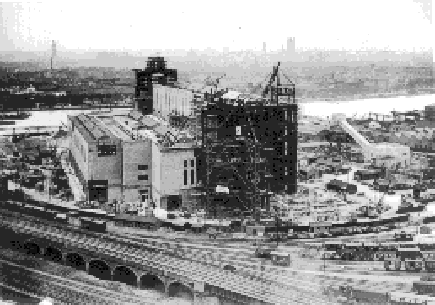
The building is in fact a steel girder frame and Sir Giles designed the exterior brick cladding and the tower-like bases of the four chimneys. It is the largest brick building in Europe.
In effect Battersea is two power stations and the familiar silhouette of four chimneys did not appear until 1953 and for the first 20 years the building had a long rather than four-square appearance, with a chimney at each end. But even this appearance caused positive comments, described as a temple of power and to rank as a London landmark equal with St. Paul's Cathedral. In 1939 a survey of celebrities voted it their 2nd favourite building when canvassed by the Architects Journal.
The construction of 'B' Station was begun a few months after World War 2 to bring Battersea to a total capacity of 509 megawatts and the 3rd. largest power station in the U.K.
This huge project, begun by the London Power company 30 years before, was to be completed by the British Electric Authority when the electricity supply was nationalised in 1948. Battersea "B" station began operating in 1953 and had the highest thermal efficiency of all power stations and provided one fifth of Londons total electricity supplies, ( 28 other stations generated the rest )
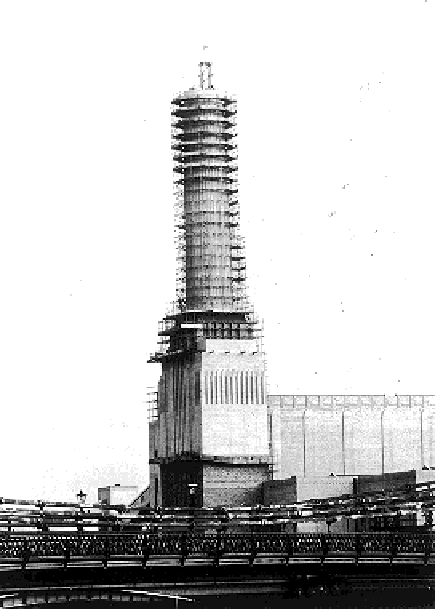
Throughout the whole of its life Battersea has been a symbol of the electricity industry to the media and the general public alike.
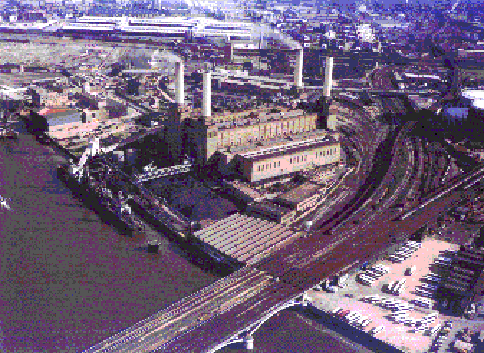
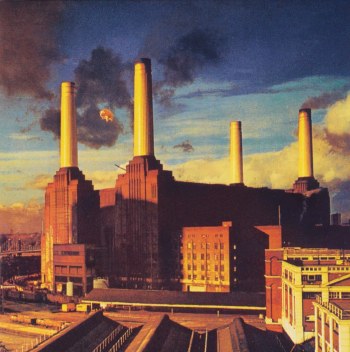
Cover of Pink Floyd Album Animals

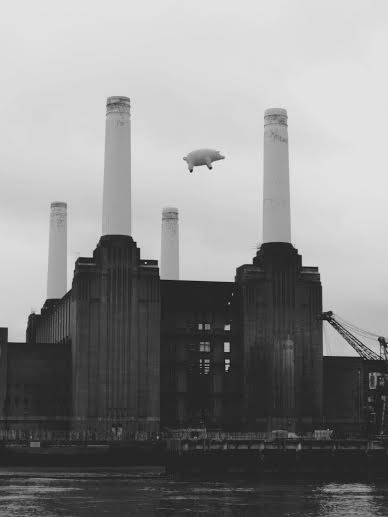
Sept 26 th 2011
